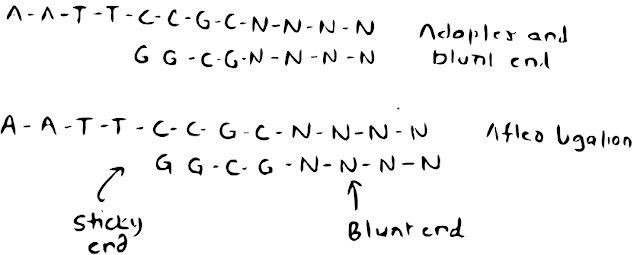Recombinant DNA Technology (RDT): The technique that enable the isolation, identification and recombination of DNA from different sources so that new unique characteristics can be introduced into an organism.
RDT is also known as genetic engineering.
The enzymes used in recombinant DNA technology fall into four broad categories.
Template dependent DNA polymerase
DNA polymerase enzyme that synthesises new polynuclear dice complimentary to the existing DNA or RNA templates are included in this category.
Different types of DNA polymerase are used in gene manipulation.
- DNA polymerase I (Kornberg Enzyme): First DNA polymerase enzyme discovered in E. coli by Arthur Kornberg.
It Possesses three enzymatic activities.
By splitting the enzyme DNA polymerase with protease (Subtilisin or Trypsin) gives,
1) Small N-terminal fragment: 5’-3’ polymerase activity——Gap filling and DNA repairing.
2) Large C-terminal fragment: 3’-5’ and 5’-3’ exonuclease activities (Klenow fragment) ——Proofreading activity, Primar removal.
- Reverse Transcriptase (RTase): Synthesize DNA from RNA template.
Discovered by Howard Temin and David Baltimore independently at a same time.
- Taq DNA polymerase: A DNA polymerase isolated from a thermostable bacterium, Thermus aquaticus.
- Exonuclease: That remove nucleotides at the end (Either 3'- or 5'-) of nucleic acid by breaking phosphodiester bond.
- Endonuclease: That break internal phosphodiester bond (in between 3'- to 5'-) within a nucleic acid.
- Mug bean Nuclease: Endonuclease, isolated from Mung Bean sprouts.
- S1 nuclease: Endonuclease, isolated from Aspergillus Oryzae.
- RNase A: Endonuclease,
- RNase H: Endonclease
- Restriction endonuclease:
Present in Bacterial cells, as a part of Protective mechanism called "Restriction Mechanism" system. In this system, the restriction enzymes hydrolyse any exogenous DNA (Viral attack) that is introduced into cell.
It does not act on host cell's DNA because Methylase (a modification enzyme) modifies particular bases in the recognition sequence and prevents the restriction enzyme from cutting the DNA.
Restriction enzymes classified into Three types,
Type I, Type II and Type III.
| Characteristics | Type I | Type II | Type III |
|---|---|---|---|
| Nature of Enzyme | Both endonuclease and methylase activity | Uni functional enzyme: Endonuclease; Methylase activity | Bifunctional: Endonuclease and Methylase activity |
| Restriction Requires | Mg²⁺ + ATP + S-adenosyl methionine | Mg²⁺ | Mg²⁺ |
| Cleavage Site | Random | At or near recognition site | ≈ 25 bp from recognition site |
| Example | EcoB | EcoRI | EcoP1 |
The existence of Restriction Enzyme was first postulated by W. Arber. he noticed when DNA of bacteriophage inter into host bacterium in cut up into smaller pieces.
In 1970, Hamilton Smith and Co- worker first isolated a restriction enzyme from bacterium Haemephilus influenzae, Hind II (six cutter).
Nomenclature: Three Parts
- Abbreviation of genus and species to three letters. e.g. E from genus Escherichia and co from species Coli.
- A letter, number or combination of two to indicate Strain.
- A Roman numeral to indicate the order in which different Restriction modification system was found.
Restriction Site: A definite length of dsDNA segment that contains particular nucleotide sequence of 4, 6 or 8 base pair length from restriction enzyme cuts DNA, known as Restriction or Recognition site.
These are generally Palindromic Sequences.
Symbol of enzyme cut = "/"
Restriction enzymes cut DNA strand into Two ways.
- Blunt end: cleave both strands at same point of axis of symmetry.
- Overhanging end: Cleave points on both strand of DNA in different symmetry. (also called Sticky or cohesive end)
staggered cut gives either 5'- overhanging end or 3'- overhanging end.
NB: The restriction site for EcoRI enzyme is 5'-GAATTC-3'.
Frequency of Recognition Points: The Number of Recognition site for particular Restriction endonuclease in a DNA molecule of known length can be measured mathematically.
The expected frequency of particular sequences = 1/4^n
Uses of Restriction Endonuclease:
- A proper amount of enzyme is added to intended DNA in a buffer solution and the reaction is heated at 27°C.
- Isoschizomers: A pair of R.E that recognize the same recognition sequences and cut in the same location.
- Neoschizomers: Recognise same sequence, cut it differently.
- Isocaudomers: Recognise slightly different sequence but produce the same ends.
- Terminal deoxynucleotidyl transferase: Template independent DNA polymerase, able to synthesise a new DNA nucleotide without base pairing of incoming nucleotides to end existing strand of DNA or RNA.
- Alkaline phosphatase: Remove phosphate groups from 5’ ends of DNA.
- T4 polynucleotide kinase: Perform reverse reaction to alkaline phosphatase.










No comments:
Post a Comment